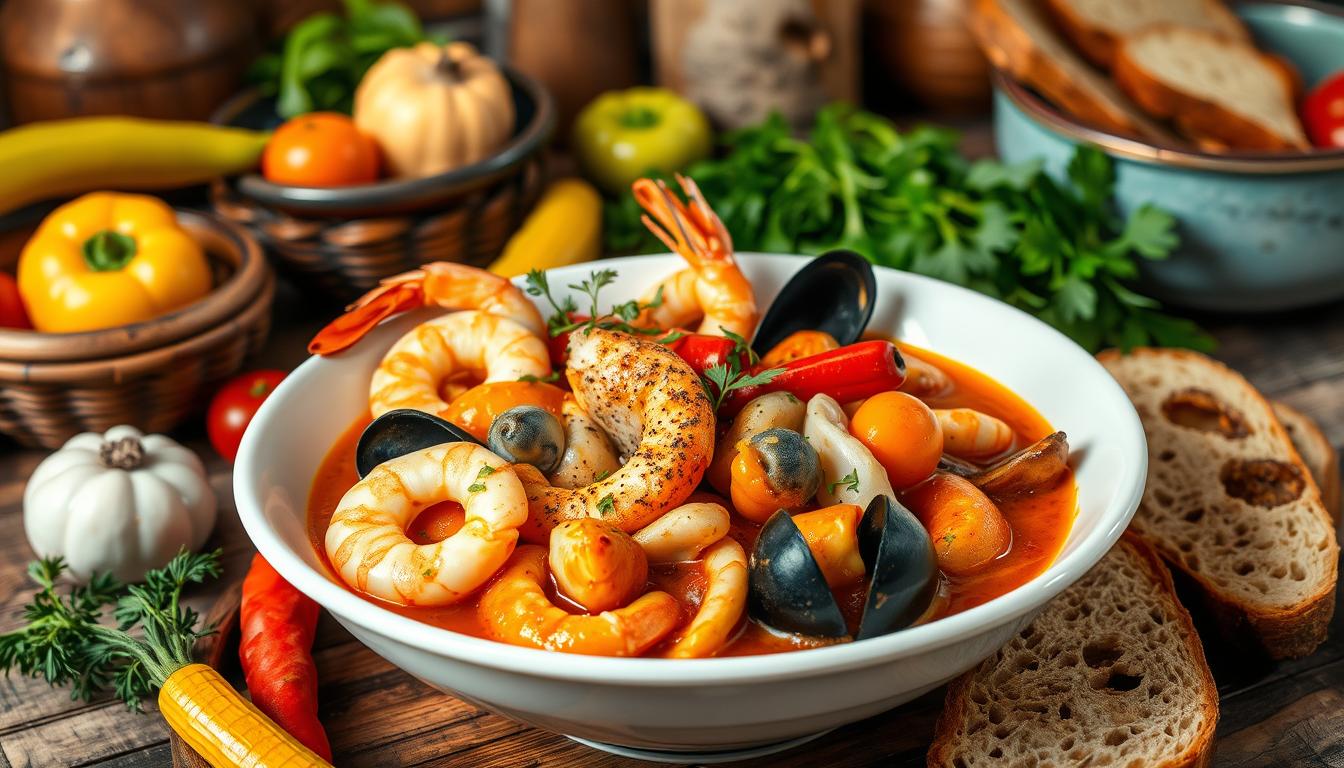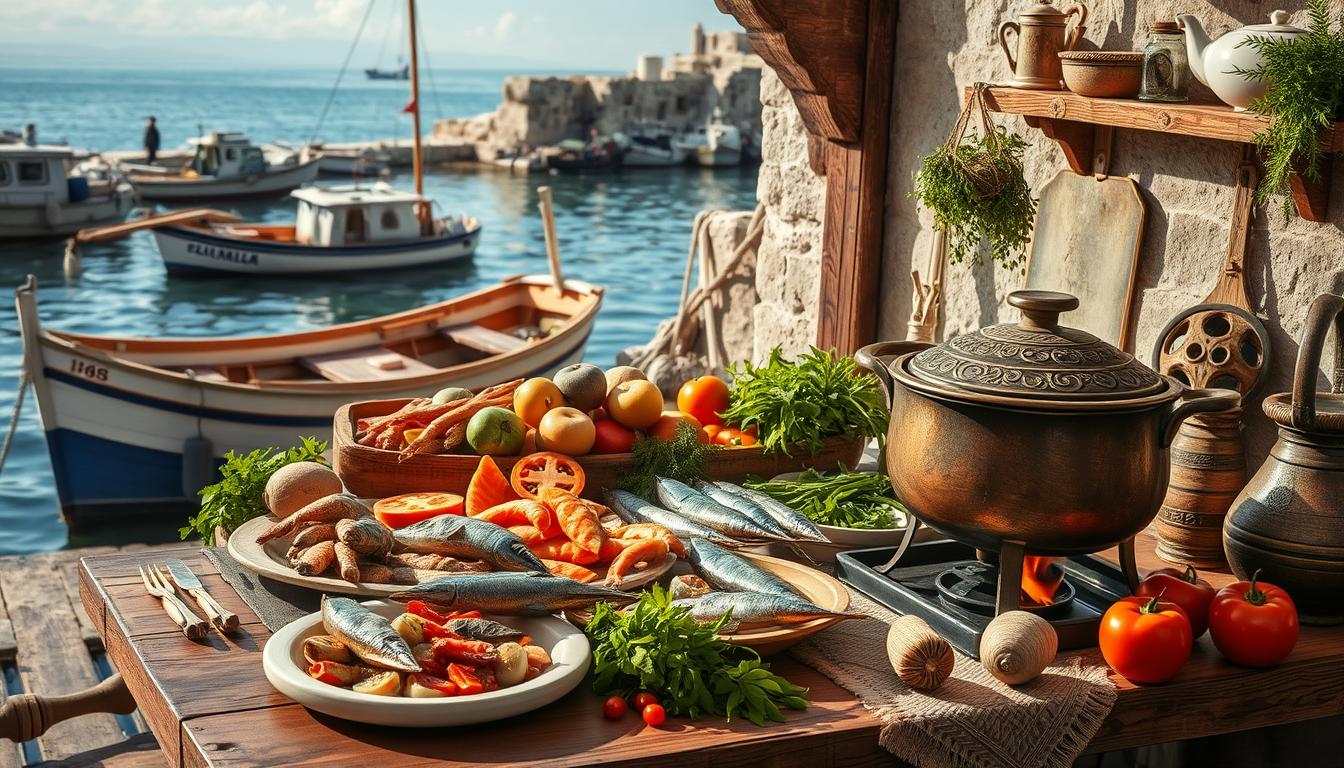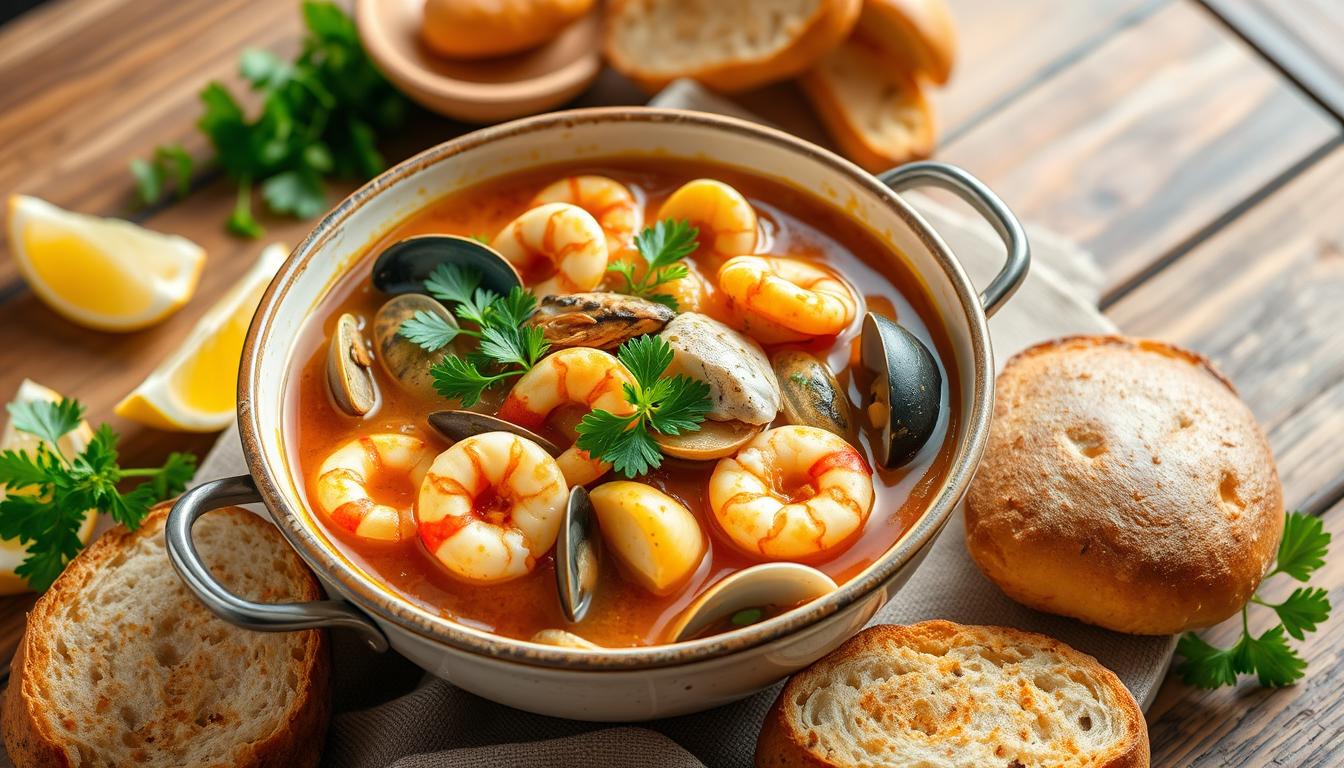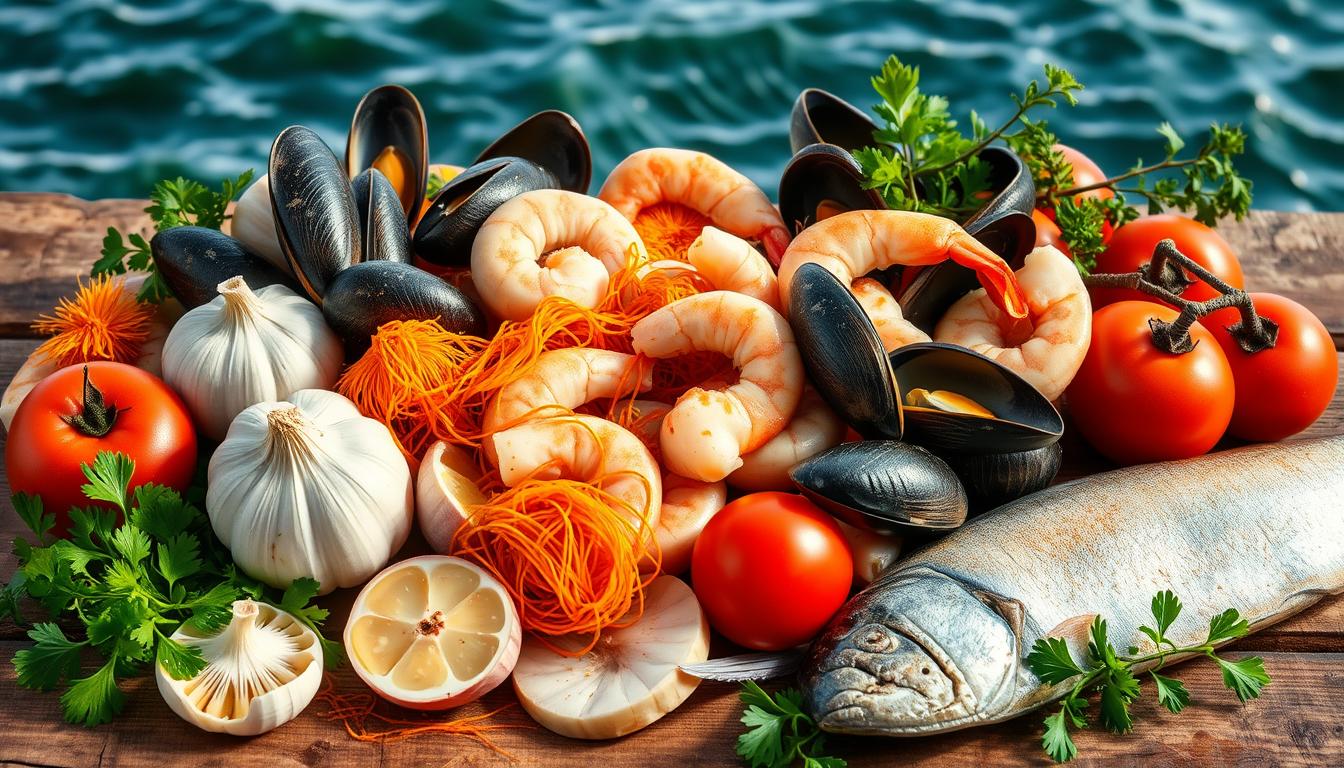Bouillabaisse Recipe
A hearty, flavorful seafood stew packed with fresh fish, shellfish, and Mediterranean herbs! Perfect for a cozy dinner or impressing your guests.
Ingredients:
- 1 lb white fish fillets (such as cod or haddock)
- 1/2 lb shrimp, peeled and deveined
- 1/2 lb mussels, scrubbed
- 1 onion, chopped
- 2 cloves garlic, minced
- 1 fennel bulb, sliced
- 2 tomatoes, chopped
- 1/4 cup olive oil
- 1/4 cup white wine
- 4 cups fish stock
- 1 tsp saffron threads
- 1 tsp dried thyme
- 1 bay leaf
- Salt and pepper to taste
- Fresh parsley, chopped (for garnish)
- Crusty bread, for serving
Instructions:
- Heat olive oil in a large pot over medium heat. Add onion, garlic, and fennel. Cook for 5 minutes until softened.
- Add tomatoes, white wine, saffron, thyme, bay leaf, salt, and pepper. Stir and let simmer for 10 minutes.
- Pour in fish stock and bring to a boil. Reduce heat and simmer for 15 minutes to allow the flavors to meld.
- Add the fish fillets, shrimp, and mussels. Cover and simmer for another 10 minutes until the fish is cooked through and the mussels have opened.
- Discard any mussels that haven’t opened. Adjust seasoning with salt and pepper if needed.
- Serve in bowls, garnished with fresh parsley and a side of crusty bread.
Easy Bouillabaisse Recipe: A Step-by-Step Guide for Beginners
Why do beginners love making bouillabaisse, a French seafood stew? It’s because it’s easy to make and full of flavor. You can follow simple steps to make a delicious bouillabaisse.
We want to help you make this tasty dish. It’s great for those new to cooking. Our recipe will guide you to make a real bouillabaisse.
Key Takeaways
- Easy bouillabaisse recipe for beginners
- Simple bouillabaisse instructions for a delicious meal
- Perfect for beginners cooking dinner
- Traditional French seafood stew with a rich history
- Our recipe provides a step-by-step guide to making bouillabaisse
- Learn how to prepare an authentic bouillabaisse with our easy recipe
The Rich History of Bouillabaisse: From Marseille to Modern Tables
Bouillabaisse is a traditional French seafood stew. It comes from Marseille. The bouillabaisse history is interesting. It shows how a simple dish became a favorite.
Marseille is by the Mediterranean Sea. It’s a place where trade and culture meet. This helped make French seafood stew recipes special.
The story of bouillabaisse starts with fishermen in Marseille. They made a stew with fish, veggies, and spices. It was a filling meal.
As time went by, the stew recipe spread. Each town made it their own. Now, bouillabaisse is a key part of Provençal food. Marseille is at the heart of this tradition.
- Origins in Marseille, France, dating back to the 16th century
- Evolution from a humble fisherman’s dish to a refined culinary delight
- Influence of Mediterranean trade and cultural exchange on the development of French seafood stew recipes
The bouillabaisse history shows how food can unite people. Bouillabaisse is loved worldwide. It brings the taste of Marseille to everyone who tries it.
Understanding Bouillabaisse: More Than Just Fish Soup
Bouillabaisse is a special seafood stew from Marseille, France. It’s not just a fish soup. It’s a rich, tasty bouillabaisse with fresh Mediterranean ingredients.
Bouillabaisse is different from other fish soups. It has many fish and shellfish like mussels and shrimp. It also has onions, garlic, and fennel for flavor.
Some key things about bouillabaisse are:
- A rich and flavorful broth with many fish and shellfish
- Vegetables and aromatics for depth and complexity
- A hearty yet refined seafood stew
In short, bouillabaisse is a unique and tasty seafood stew. It’s perfect for those who love fish soup or want to try something new.
| Ingredient | Description |
|---|---|
| Fish and Shellfish | A variety of fresh fish and shellfish, including mussels, clams, and shrimp |
| Vegetables and Aromatics | Onions, garlic, fennel, and other vegetables and aromatics to add depth and complexity |
| Broth | A rich and flavorful broth made with a combination of fish and shellfish stock, vegetables, and aromatics |
Essential Ingredients for an Authentic Bouillabaisse
To make a real bouillabaisse, you need the right bouillabaisse ingredients. This dish is a big fish stew from Marseille, France. Its special taste comes from seafood components, herbs and spices.
The traditional seafood components are many fish and shellfish. Like mussels, clams, and shrimp. They mix with herbs and spices like thyme, bay leaves, and saffron. This makes a deep, tasty broth.
Traditional Seafood Components
- Mussels
- Clams
- Shrimp
- Other varieties of fish and shellfish
Key Herbs and Spices
The herbs and spices in bouillabaisse are as important as the seafood components. Some key ones are:
- Thyme
- Bay leaves
- Saffron
The Role of Saffron
Saffron is very important in bouillabaisse. It gives the dish a special flavor and color. Make sure to use good-quality saffron for the best taste.
| Ingredient | Quantity |
|---|---|
| Saffron | 1/2 teaspoon |
| Thyme | 2 sprigs |
| Bay leaves | 2 leaves |
Easy Bouillabaisse Recipe for Beginners
To make a tasty bouillabaisse, you need the right tools and a plan. Our easy recipe helps beginners make a dish that wows everyone.
Equipment Needed
You’ll need a big pot, tools for prep, and dishes for serving. The right tools make cooking fun and easy.
Preparation Steps
First, prep the fish and shellfish. Then, make the broth. Our recipe guides you through each step.
Cooking Timeline
A good plan is key for a tasty bouillabaisse. Our recipe has a simple timeline for prep, cooking, and serving. Follow it to make a dish that tastes amazing.
With our recipe and timeline, beginners can make a great bouillabaisse. It’s perfect for any meal. With practice, you’ll impress everyone with your bouillabaisse.
Budget-Friendly Adaptations Without Sacrificing Flavor
To make a tasty bouillabaisse without spending a lot, try these tips. Use cheaper fish like cod or mussels. They taste great and save money.
Make the most of what you have. Use fish heads and bones for a rich broth. This is a key part of bouillabaisse. Here’s how to start:
- Shop for seasonal and locally sourced ingredients to reduce costs
- Use herbs and spices to add flavor instead of relying on expensive ingredients
- Consider making a smaller batch of bouillabaisse to reduce waste and save money
These tips let you enjoy bouillabaisse’s rich taste without spending a lot.
With a bit of creativity, you can make a delicious bouillabaisse. It’s affordable and full of flavor. Whether you’re experienced or new to cooking, these tips will help you enjoy a tasty meal.
| Ingredient | Budget-Friendly Alternative |
|---|---|
| Fish | Cod or tilapia |
| Shellfish | Mussels or clams |
| Broth | Homemade fish stock using fish heads and bones |
The Perfect Rouille: Making the Essential Accompaniment
To finish the bouillabaisse, a special sauce called rouille is added. It’s like mayonnaise but tastes richer. To make it, you need traditional ingredients and step-by-step instructions.
Traditional Ingredients
The key ingredients for rouille are olive oil, garlic, and saffron. These mix with egg yolks and lemon juice. This makes the sauce smooth and creamy.
Step-by-Step Instructions
To make the best rouille, follow these step-by-step instructions:
- Combine egg yolks, garlic, and saffron in a bowl.
- Slowly add olive oil, whisking continuously.
- Add lemon juice and season with salt and pepper.
With these traditional ingredients and step-by-step instructions, you can make a tasty rouille. Serve it with your bouillabaisse.
Common Mistakes to Avoid When Making Bouillabaisse
When making bouillabaisse, it’s key to know common mistakes. One big error is using the wrong fish and shellfish. Choosing the right seafood is very important for the taste.
Another mistake is not preparing ingredients well. This means not chopping vegetables finely enough or not cooking the broth long enough. Here are some tips to help you avoid these mistakes:
- Use a variety of fish and shellfish for a rich flavor.
- Chop the vegetables finely so they cook evenly and quickly.
- Cook the broth for at least 20-30 minutes to get all the flavors.
By following these tips, you can make a delicious bouillabaisse. It will impress your family and friends. Remember, making it perfect takes practice. Don’t get discouraged if it’s not perfect the first time. Keep trying, and you’ll get better.
With these tips and a bit of practice, you’ll make a tasty bouillabaisse. It will be full of flavor and won’t have common mistakes.
| Mistake | Tips to Avoid |
|---|---|
| Using the wrong seafood | Choose a variety of fish and shellfish for a rich flavor profile |
| Not preparing ingredients properly | Chop vegetables finely and cook the broth for at least 20-30 minutes |
| Not cooking the broth for the right amount of time | Cook the broth for at least 20-30 minutes to extract all the flavors |
Bouillabaisse vs. Cioppino: Understanding the Difference
Seafood stews like bouillabaisse and cioppino are favorites. They taste great but come from different places. They use different ingredients and cooking ways.
Bouillabaisse comes from Marseille, France. It’s been loved for ages. Cioppino, from San Francisco, California, has Italian roots. This shows in their ingredients. Bouillabaisse has fish and shellfish like mussels and shrimp. Cioppino has seafood like fish, scallops, and squid.
Comparison of Ingredients and Preparation Methods
- Bouillabaisse: has a broth with fish stock, veggies, and spices. It’s served with croutons and rouille.
- Cioppino: has a tomato broth. It’s served with crusty bread.
Bouillabaisse cooks slowly in a big pot. Cioppino cooks fast in a skillet. These ways make each dish taste and feel different.
Knowing the difference between bouillabaisse and cioppino helps you enjoy each dish more. You might like bouillabaisse’s rich taste or cioppino’s tomato flavor. Both will make your seafood cravings happy.
| Dish | Origin | Ingredients | Preparation Method |
|---|---|---|---|
| Bouillabaisse | Marseille, France | Fish, shellfish, vegetables, aromatics | Low heat, large pot |
| Cioppino | San Francisco, California | Seafood, tomatoes, white wine | Medium-high heat, skillet |
Wine Pairing and Serving Suggestions
Choosing the right wine for bouillabaisse is fun. A dry white wine like Sauvignon Blanc goes well with its rich taste. Or, try a rosé from Provence for a traditional touch.
To serve bouillabaisse, use a big, shallow bowl. Add croutons and rouille on top. This makes the dish look and taste great. Here are some wine choices:
- Sauvignon Blanc: pairs well with the citrus and herbal notes in the bouillabaisse
- Provence rosé: complements the bold flavors of the dish with its dry and fruity notes
- Vermentino: a white wine with herbal and citrus notes that pairs nicely with the seafood flavors
Finding the right wine can make bouillabaisse even better. Try different wines to find your favorite. With these tips, your meal will be unforgettable.
| Wine | Pairing Notes |
|---|---|
| Sauvignon Blanc | Citrus and herbal notes complement the bouillabaisse |
| Provence rosé | Dry and fruity notes complement the bold flavors |
| Vermentino | Herbal and citrus notes pair nicely with seafood flavors |
Health Benefits of This Mediterranean Dish
Bouillabaisse is a tasty dish from the Mediterranean. It’s full of protein, omega-3s, and antioxidants. These make it great for a healthy diet.
This dish is good for you because of its nutrients. Here are some of the benefits:
- Reduced inflammation: The omega-3s in fish and shellfish fight inflammation. This can lower disease risks.
- Improved heart health: Bouillabaisse’s protein, omega-3s, and antioxidants help the heart. They can lower bad fats and blood pressure.
- Weight management: With lots of protein and not many calories, bouillabaisse helps with weight control.
Bouillabaisse is both healthy and tasty. It’s a great choice for anyone wanting to feel better. It’s full of nutrients that are good for you.
Storage and Reheating Tips
Storing and reheating bouillabaisse needs some tips. It’s important to keep the flavor and texture right. Let the bouillabaisse cool down to room temperature before you put it in the fridge or freezer.
Here are some reheating tips to consider:
- Reheat the bouillabaisse over low heat, stirring occasionally, to prevent the fish from breaking apart.
- Add a little water or broth if the bouillabaisse has thickened too much during storage.
- Reheat the bouillabaisse to an internal temperature of at least 165°F (74°C) to ensure food safety.
By following these tips, you can enjoy your bouillabaisse for several days after cooking it. It will still taste fresh and delicious. Always check the bouillabaisse for any signs of spoilage before reheating it.
“The key to successful reheating is to do it gently, without overheating the bouillabaisse, which can cause the fish to become tough and dry.”
Conclusion: Mastering Your Homemade Bouillabaisse
We’ve explored the rich history and flavors of bouillabaisse. Now, it’s time to master this seafood stew in your kitchen. Follow the steps in this guide to make the authentic broth and perfectly cooked seafood.
The secret to mastering homemade bouillabaisse is using fresh ingredients. Also, simmer the broth patiently and present the seafood beautifully. Soon, you’ll feel like you’re in Marseille with every bite.
So, start now! Get your ingredients ready and put on your apron. Show off your skills to your family and friends. They’ll love it. Bon appétit!
FAQ
What is bouillabaisse?
Bouillabaisse is a French seafood stew from Marseille. It has a rich broth with fish, shellfish, veggies, and spices.
What are the key ingredients in bouillabaisse?
Bouillabaisse has fish, shrimp, mussels, and clams. It also has onions, fennel, tomatoes, and herbs like saffron and thyme.
How do I make an authentic bouillabaisse?
To make real bouillabaisse, use a recipe with seafood, herbs, and spices. Our easy recipe for beginners will guide you.
What’s the difference between bouillabaisse and cioppino?
Bouillabaisse comes from Marseille, France, with many seafood types. Cioppino is Italian-American, often with tomato broth.
What kind of wine pairs well with bouillabaisse?
Sauvignon Blanc or rosé from Provence are great with bouillabaisse. They match the broth’s richness with their acidity and fruitiness.
What are some common mistakes to avoid when making bouillabaisse?
Avoid using wrong fish and shellfish, not prepping ingredients, and not cooking the broth enough. Our guide helps you avoid these mistakes.
How can I make bouillabaisse on a budget?
To make bouillabaisse cheaply, use affordable fish and shellfish. Use what you have at home. Our budget tips will help you save money.
Link source:
- Link: Mediterranean Seafood Guide
- Anchor Text: Explore different Mediterranean seafood varieties used in Bouillabaisse
- Link: History of Bouillabaisse in Marseille
- Anchor Text: Learn about the rich history of Bouillabaisse in Marseille
- Link: The Health Benefits of Seafood
- Anchor Text: Discover the health benefits of including seafood in your diet










